Crime and Criminals: A Sociological Analysis of Social Construction
VerifiedAdded on 2023/06/08
|8
|2284
|400
Essay
AI Summary
This essay delves into the sociological understanding of crime and criminals as socially constructed phenomena. It begins by defining crime and explaining its construction through societal norms, laws, and the influence of social groups. The essay explores the three levels of crime causes, including biological, social behavior, and societal perception. It then examines various theoretical perspectives, such as Durkheim's theories on anomie and social control and the Marxist perspective on crime and social order. The essay also considers the role of individual choice and rational decision-making in criminal behavior. The conclusion highlights the functionalist and interactionist approaches to crime, emphasizing the complexities of defining and understanding crime within society. The essay uses references to support the arguments and analysis of the topic.
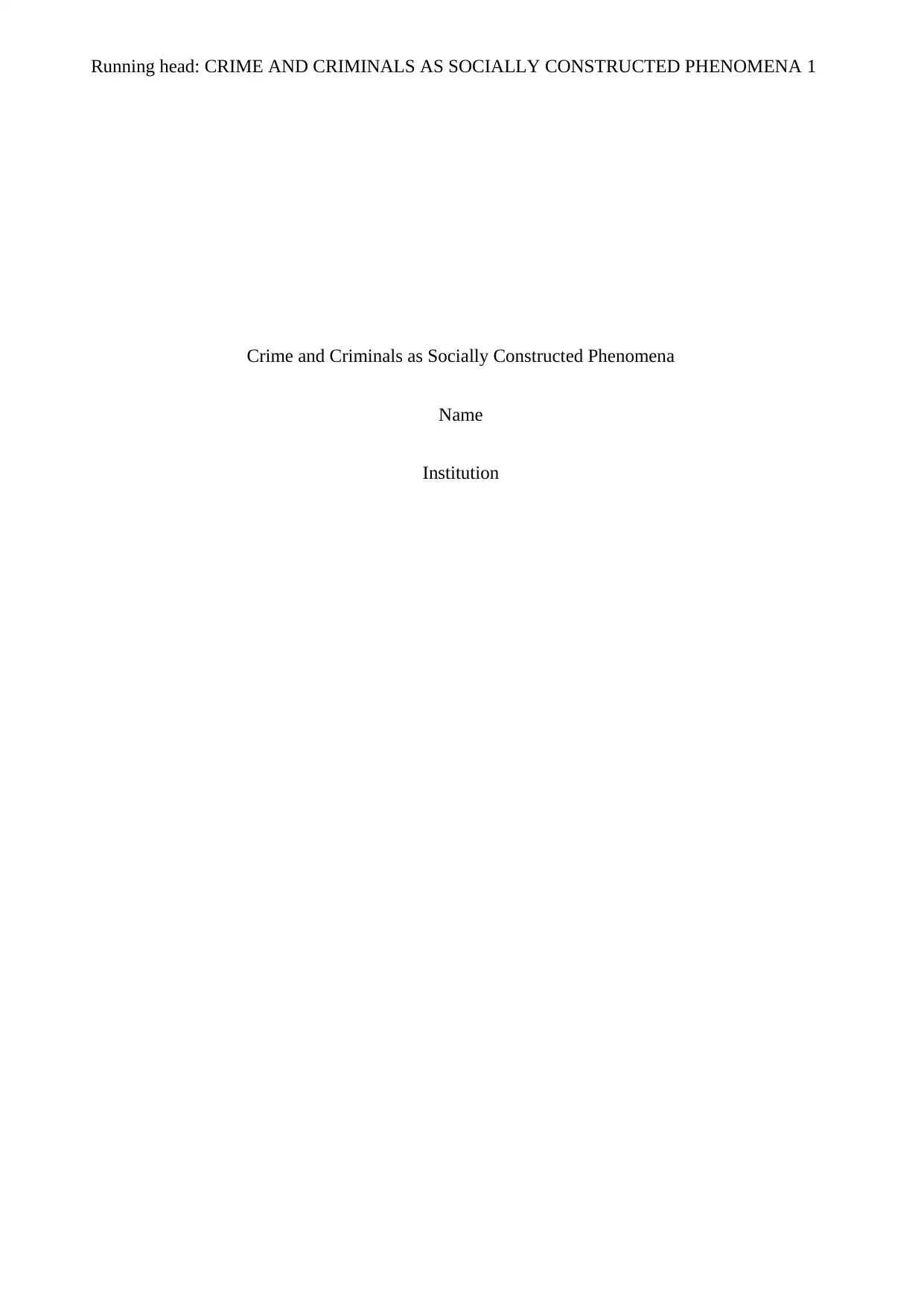
Running head: CRIME AND CRIMINALS AS SOCIALLY CONSTRUCTED PHENOMENA 1
Crime and Criminals as Socially Constructed Phenomena
Name
Institution
Crime and Criminals as Socially Constructed Phenomena
Name
Institution
Paraphrase This Document
Need a fresh take? Get an instant paraphrase of this document with our AI Paraphraser
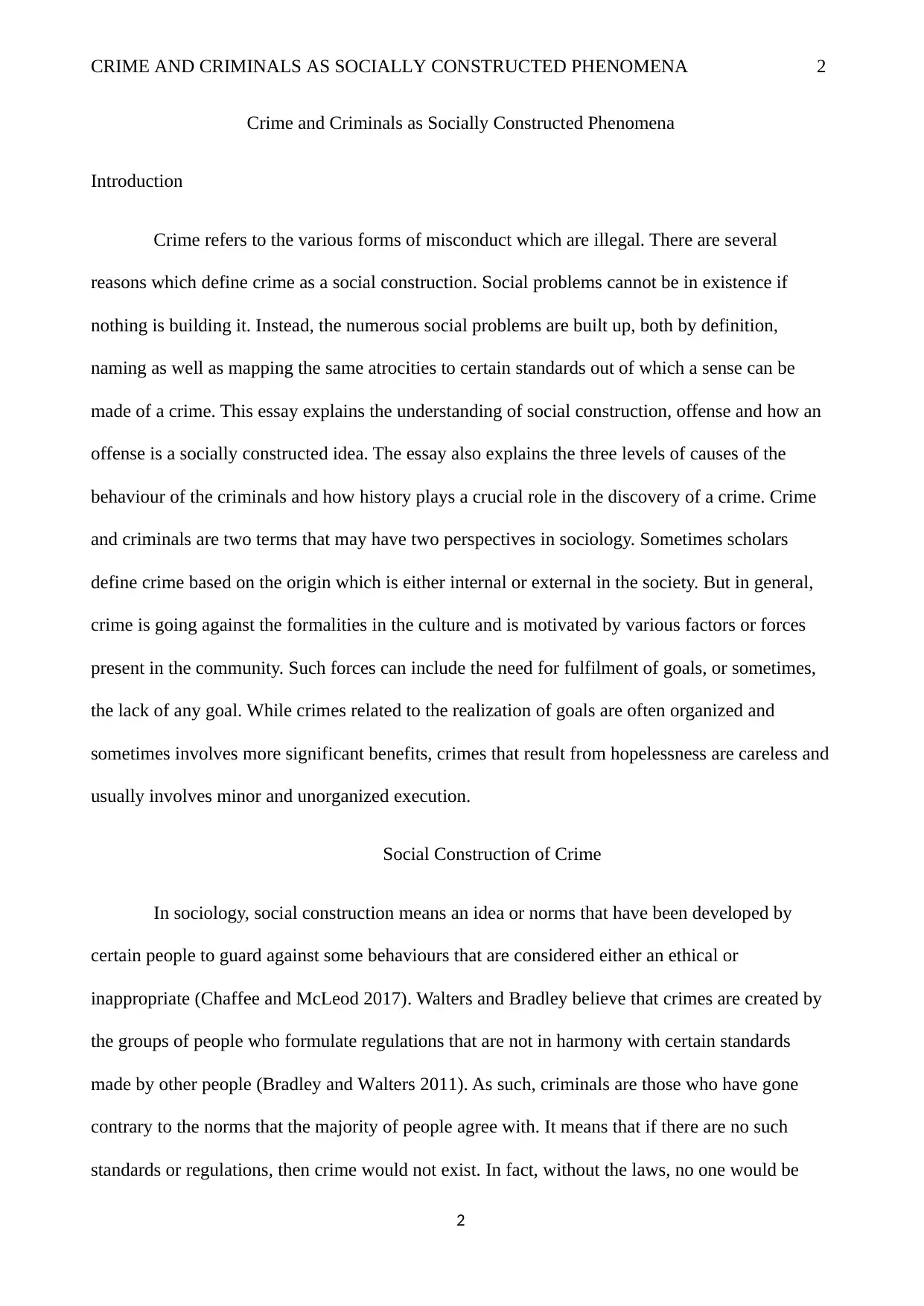
CRIME AND CRIMINALS AS SOCIALLY CONSTRUCTED PHENOMENA 2
Crime and Criminals as Socially Constructed Phenomena
Introduction
Crime refers to the various forms of misconduct which are illegal. There are several
reasons which define crime as a social construction. Social problems cannot be in existence if
nothing is building it. Instead, the numerous social problems are built up, both by definition,
naming as well as mapping the same atrocities to certain standards out of which a sense can be
made of a crime. This essay explains the understanding of social construction, offense and how an
offense is a socially constructed idea. The essay also explains the three levels of causes of the
behaviour of the criminals and how history plays a crucial role in the discovery of a crime. Crime
and criminals are two terms that may have two perspectives in sociology. Sometimes scholars
define crime based on the origin which is either internal or external in the society. But in general,
crime is going against the formalities in the culture and is motivated by various factors or forces
present in the community. Such forces can include the need for fulfilment of goals, or sometimes,
the lack of any goal. While crimes related to the realization of goals are often organized and
sometimes involves more significant benefits, crimes that result from hopelessness are careless and
usually involves minor and unorganized execution.
Social Construction of Crime
In sociology, social construction means an idea or norms that have been developed by
certain people to guard against some behaviours that are considered either an ethical or
inappropriate (Chaffee and McLeod 2017). Walters and Bradley believe that crimes are created by
the groups of people who formulate regulations that are not in harmony with certain standards
made by other people (Bradley and Walters 2011). As such, criminals are those who have gone
contrary to the norms that the majority of people agree with. It means that if there are no such
standards or regulations, then crime would not exist. In fact, without the laws, no one would be
2
Crime and Criminals as Socially Constructed Phenomena
Introduction
Crime refers to the various forms of misconduct which are illegal. There are several
reasons which define crime as a social construction. Social problems cannot be in existence if
nothing is building it. Instead, the numerous social problems are built up, both by definition,
naming as well as mapping the same atrocities to certain standards out of which a sense can be
made of a crime. This essay explains the understanding of social construction, offense and how an
offense is a socially constructed idea. The essay also explains the three levels of causes of the
behaviour of the criminals and how history plays a crucial role in the discovery of a crime. Crime
and criminals are two terms that may have two perspectives in sociology. Sometimes scholars
define crime based on the origin which is either internal or external in the society. But in general,
crime is going against the formalities in the culture and is motivated by various factors or forces
present in the community. Such forces can include the need for fulfilment of goals, or sometimes,
the lack of any goal. While crimes related to the realization of goals are often organized and
sometimes involves more significant benefits, crimes that result from hopelessness are careless and
usually involves minor and unorganized execution.
Social Construction of Crime
In sociology, social construction means an idea or norms that have been developed by
certain people to guard against some behaviours that are considered either an ethical or
inappropriate (Chaffee and McLeod 2017). Walters and Bradley believe that crimes are created by
the groups of people who formulate regulations that are not in harmony with certain standards
made by other people (Bradley and Walters 2011). As such, criminals are those who have gone
contrary to the norms that the majority of people agree with. It means that if there are no such
standards or regulations, then crime would not exist. In fact, without the laws, no one would be
2
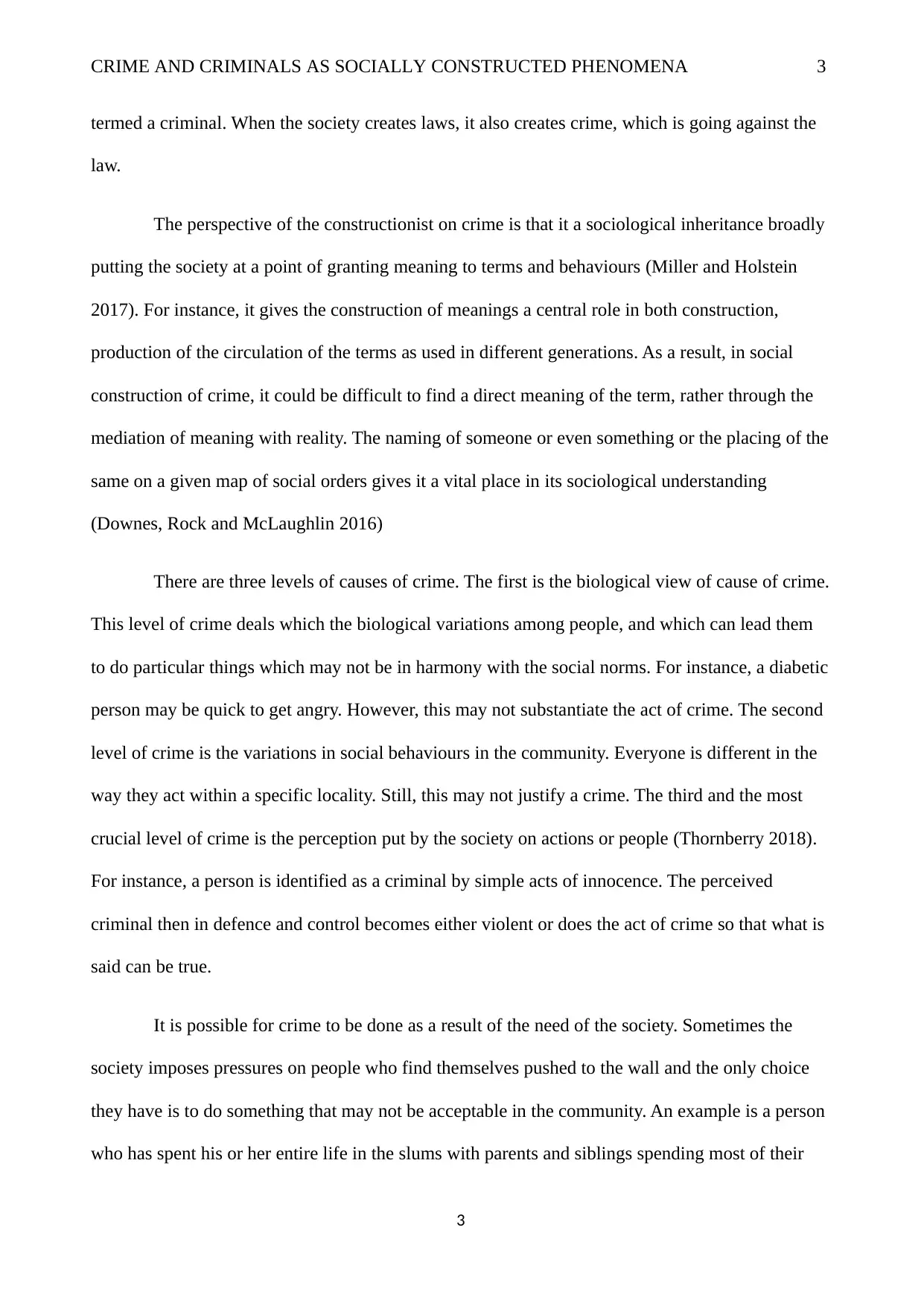
CRIME AND CRIMINALS AS SOCIALLY CONSTRUCTED PHENOMENA 3
termed a criminal. When the society creates laws, it also creates crime, which is going against the
law.
The perspective of the constructionist on crime is that it a sociological inheritance broadly
putting the society at a point of granting meaning to terms and behaviours (Miller and Holstein
2017). For instance, it gives the construction of meanings a central role in both construction,
production of the circulation of the terms as used in different generations. As a result, in social
construction of crime, it could be difficult to find a direct meaning of the term, rather through the
mediation of meaning with reality. The naming of someone or even something or the placing of the
same on a given map of social orders gives it a vital place in its sociological understanding
(Downes, Rock and McLaughlin 2016)
There are three levels of causes of crime. The first is the biological view of cause of crime.
This level of crime deals which the biological variations among people, and which can lead them
to do particular things which may not be in harmony with the social norms. For instance, a diabetic
person may be quick to get angry. However, this may not substantiate the act of crime. The second
level of crime is the variations in social behaviours in the community. Everyone is different in the
way they act within a specific locality. Still, this may not justify a crime. The third and the most
crucial level of crime is the perception put by the society on actions or people (Thornberry 2018).
For instance, a person is identified as a criminal by simple acts of innocence. The perceived
criminal then in defence and control becomes either violent or does the act of crime so that what is
said can be true.
It is possible for crime to be done as a result of the need of the society. Sometimes the
society imposes pressures on people who find themselves pushed to the wall and the only choice
they have is to do something that may not be acceptable in the community. An example is a person
who has spent his or her entire life in the slums with parents and siblings spending most of their
3
termed a criminal. When the society creates laws, it also creates crime, which is going against the
law.
The perspective of the constructionist on crime is that it a sociological inheritance broadly
putting the society at a point of granting meaning to terms and behaviours (Miller and Holstein
2017). For instance, it gives the construction of meanings a central role in both construction,
production of the circulation of the terms as used in different generations. As a result, in social
construction of crime, it could be difficult to find a direct meaning of the term, rather through the
mediation of meaning with reality. The naming of someone or even something or the placing of the
same on a given map of social orders gives it a vital place in its sociological understanding
(Downes, Rock and McLaughlin 2016)
There are three levels of causes of crime. The first is the biological view of cause of crime.
This level of crime deals which the biological variations among people, and which can lead them
to do particular things which may not be in harmony with the social norms. For instance, a diabetic
person may be quick to get angry. However, this may not substantiate the act of crime. The second
level of crime is the variations in social behaviours in the community. Everyone is different in the
way they act within a specific locality. Still, this may not justify a crime. The third and the most
crucial level of crime is the perception put by the society on actions or people (Thornberry 2018).
For instance, a person is identified as a criminal by simple acts of innocence. The perceived
criminal then in defence and control becomes either violent or does the act of crime so that what is
said can be true.
It is possible for crime to be done as a result of the need of the society. Sometimes the
society imposes pressures on people who find themselves pushed to the wall and the only choice
they have is to do something that may not be acceptable in the community. An example is a person
who has spent his or her entire life in the slums with parents and siblings spending most of their
3
⊘ This is a preview!⊘
Do you want full access?
Subscribe today to unlock all pages.

Trusted by 1+ million students worldwide
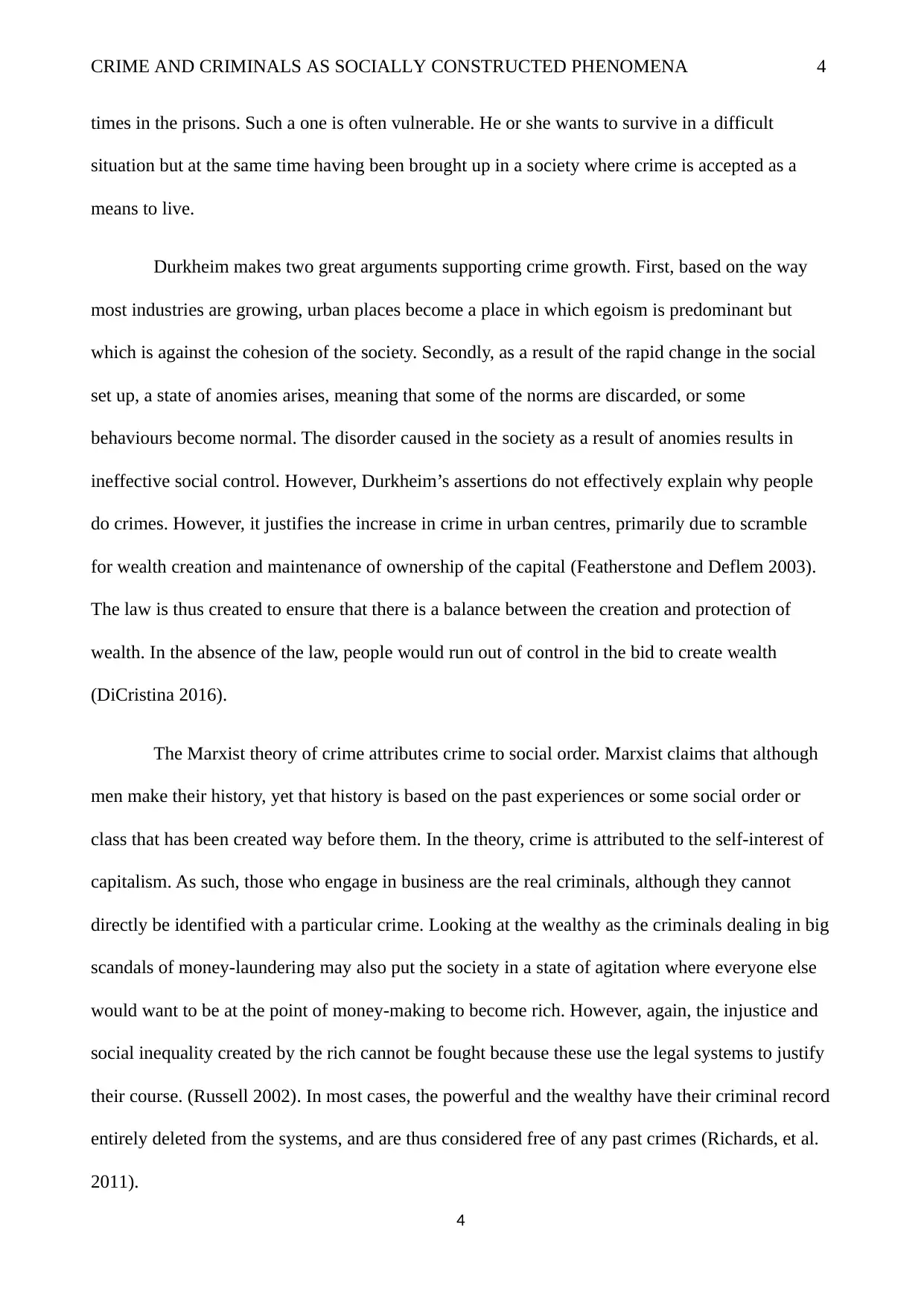
CRIME AND CRIMINALS AS SOCIALLY CONSTRUCTED PHENOMENA 4
times in the prisons. Such a one is often vulnerable. He or she wants to survive in a difficult
situation but at the same time having been brought up in a society where crime is accepted as a
means to live.
Durkheim makes two great arguments supporting crime growth. First, based on the way
most industries are growing, urban places become a place in which egoism is predominant but
which is against the cohesion of the society. Secondly, as a result of the rapid change in the social
set up, a state of anomies arises, meaning that some of the norms are discarded, or some
behaviours become normal. The disorder caused in the society as a result of anomies results in
ineffective social control. However, Durkheim’s assertions do not effectively explain why people
do crimes. However, it justifies the increase in crime in urban centres, primarily due to scramble
for wealth creation and maintenance of ownership of the capital (Featherstone and Deflem 2003).
The law is thus created to ensure that there is a balance between the creation and protection of
wealth. In the absence of the law, people would run out of control in the bid to create wealth
(DiCristina 2016).
The Marxist theory of crime attributes crime to social order. Marxist claims that although
men make their history, yet that history is based on the past experiences or some social order or
class that has been created way before them. In the theory, crime is attributed to the self-interest of
capitalism. As such, those who engage in business are the real criminals, although they cannot
directly be identified with a particular crime. Looking at the wealthy as the criminals dealing in big
scandals of money-laundering may also put the society in a state of agitation where everyone else
would want to be at the point of money-making to become rich. However, again, the injustice and
social inequality created by the rich cannot be fought because these use the legal systems to justify
their course. (Russell 2002). In most cases, the powerful and the wealthy have their criminal record
entirely deleted from the systems, and are thus considered free of any past crimes (Richards, et al.
2011).
4
times in the prisons. Such a one is often vulnerable. He or she wants to survive in a difficult
situation but at the same time having been brought up in a society where crime is accepted as a
means to live.
Durkheim makes two great arguments supporting crime growth. First, based on the way
most industries are growing, urban places become a place in which egoism is predominant but
which is against the cohesion of the society. Secondly, as a result of the rapid change in the social
set up, a state of anomies arises, meaning that some of the norms are discarded, or some
behaviours become normal. The disorder caused in the society as a result of anomies results in
ineffective social control. However, Durkheim’s assertions do not effectively explain why people
do crimes. However, it justifies the increase in crime in urban centres, primarily due to scramble
for wealth creation and maintenance of ownership of the capital (Featherstone and Deflem 2003).
The law is thus created to ensure that there is a balance between the creation and protection of
wealth. In the absence of the law, people would run out of control in the bid to create wealth
(DiCristina 2016).
The Marxist theory of crime attributes crime to social order. Marxist claims that although
men make their history, yet that history is based on the past experiences or some social order or
class that has been created way before them. In the theory, crime is attributed to the self-interest of
capitalism. As such, those who engage in business are the real criminals, although they cannot
directly be identified with a particular crime. Looking at the wealthy as the criminals dealing in big
scandals of money-laundering may also put the society in a state of agitation where everyone else
would want to be at the point of money-making to become rich. However, again, the injustice and
social inequality created by the rich cannot be fought because these use the legal systems to justify
their course. (Russell 2002). In most cases, the powerful and the wealthy have their criminal record
entirely deleted from the systems, and are thus considered free of any past crimes (Richards, et al.
2011).
4
Paraphrase This Document
Need a fresh take? Get an instant paraphrase of this document with our AI Paraphraser
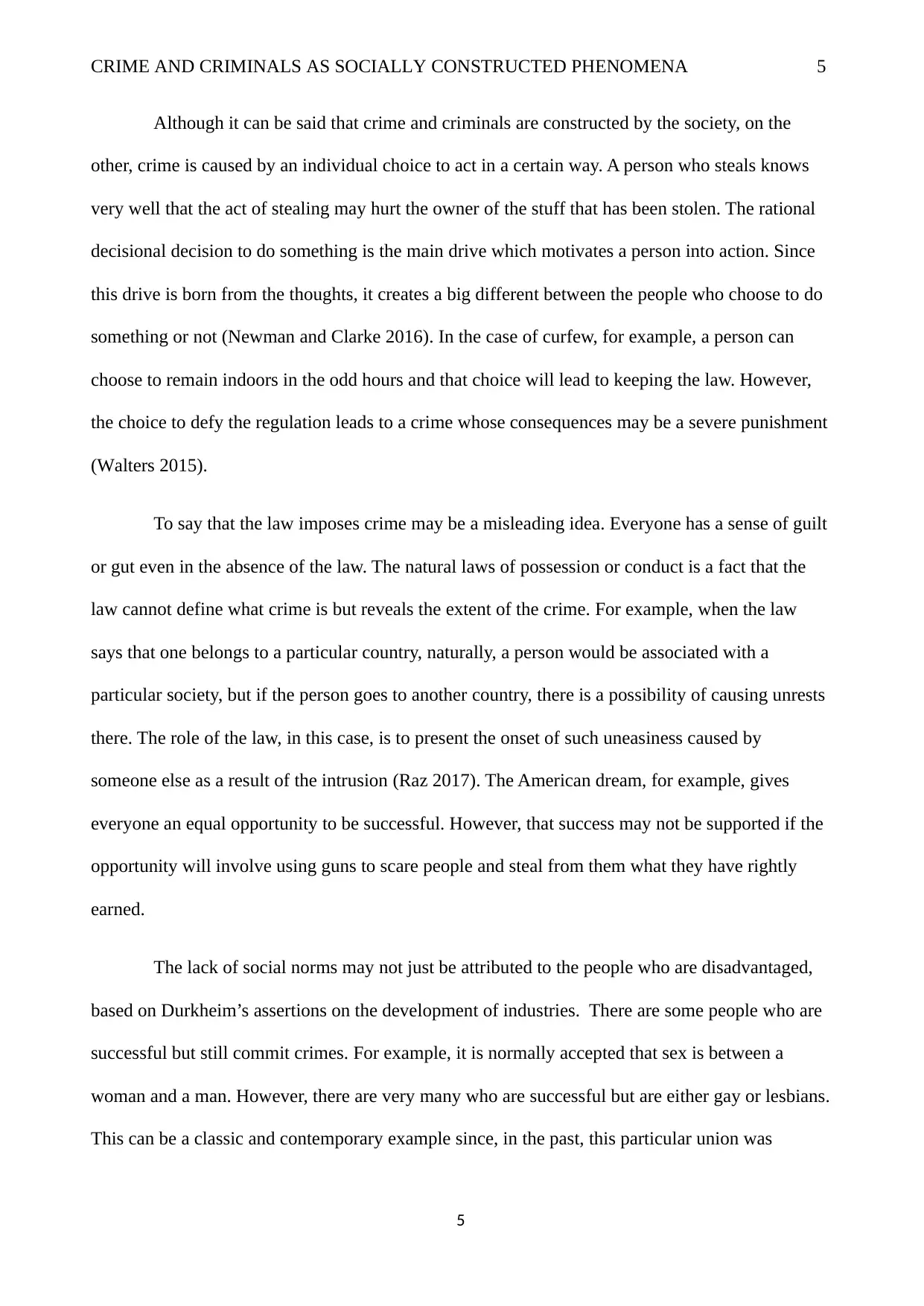
CRIME AND CRIMINALS AS SOCIALLY CONSTRUCTED PHENOMENA 5
Although it can be said that crime and criminals are constructed by the society, on the
other, crime is caused by an individual choice to act in a certain way. A person who steals knows
very well that the act of stealing may hurt the owner of the stuff that has been stolen. The rational
decisional decision to do something is the main drive which motivates a person into action. Since
this drive is born from the thoughts, it creates a big different between the people who choose to do
something or not (Newman and Clarke 2016). In the case of curfew, for example, a person can
choose to remain indoors in the odd hours and that choice will lead to keeping the law. However,
the choice to defy the regulation leads to a crime whose consequences may be a severe punishment
(Walters 2015).
To say that the law imposes crime may be a misleading idea. Everyone has a sense of guilt
or gut even in the absence of the law. The natural laws of possession or conduct is a fact that the
law cannot define what crime is but reveals the extent of the crime. For example, when the law
says that one belongs to a particular country, naturally, a person would be associated with a
particular society, but if the person goes to another country, there is a possibility of causing unrests
there. The role of the law, in this case, is to present the onset of such uneasiness caused by
someone else as a result of the intrusion (Raz 2017). The American dream, for example, gives
everyone an equal opportunity to be successful. However, that success may not be supported if the
opportunity will involve using guns to scare people and steal from them what they have rightly
earned.
The lack of social norms may not just be attributed to the people who are disadvantaged,
based on Durkheim’s assertions on the development of industries. There are some people who are
successful but still commit crimes. For example, it is normally accepted that sex is between a
woman and a man. However, there are very many who are successful but are either gay or lesbians.
This can be a classic and contemporary example since, in the past, this particular union was
5
Although it can be said that crime and criminals are constructed by the society, on the
other, crime is caused by an individual choice to act in a certain way. A person who steals knows
very well that the act of stealing may hurt the owner of the stuff that has been stolen. The rational
decisional decision to do something is the main drive which motivates a person into action. Since
this drive is born from the thoughts, it creates a big different between the people who choose to do
something or not (Newman and Clarke 2016). In the case of curfew, for example, a person can
choose to remain indoors in the odd hours and that choice will lead to keeping the law. However,
the choice to defy the regulation leads to a crime whose consequences may be a severe punishment
(Walters 2015).
To say that the law imposes crime may be a misleading idea. Everyone has a sense of guilt
or gut even in the absence of the law. The natural laws of possession or conduct is a fact that the
law cannot define what crime is but reveals the extent of the crime. For example, when the law
says that one belongs to a particular country, naturally, a person would be associated with a
particular society, but if the person goes to another country, there is a possibility of causing unrests
there. The role of the law, in this case, is to present the onset of such uneasiness caused by
someone else as a result of the intrusion (Raz 2017). The American dream, for example, gives
everyone an equal opportunity to be successful. However, that success may not be supported if the
opportunity will involve using guns to scare people and steal from them what they have rightly
earned.
The lack of social norms may not just be attributed to the people who are disadvantaged,
based on Durkheim’s assertions on the development of industries. There are some people who are
successful but still commit crimes. For example, it is normally accepted that sex is between a
woman and a man. However, there are very many who are successful but are either gay or lesbians.
This can be a classic and contemporary example since, in the past, this particular union was
5
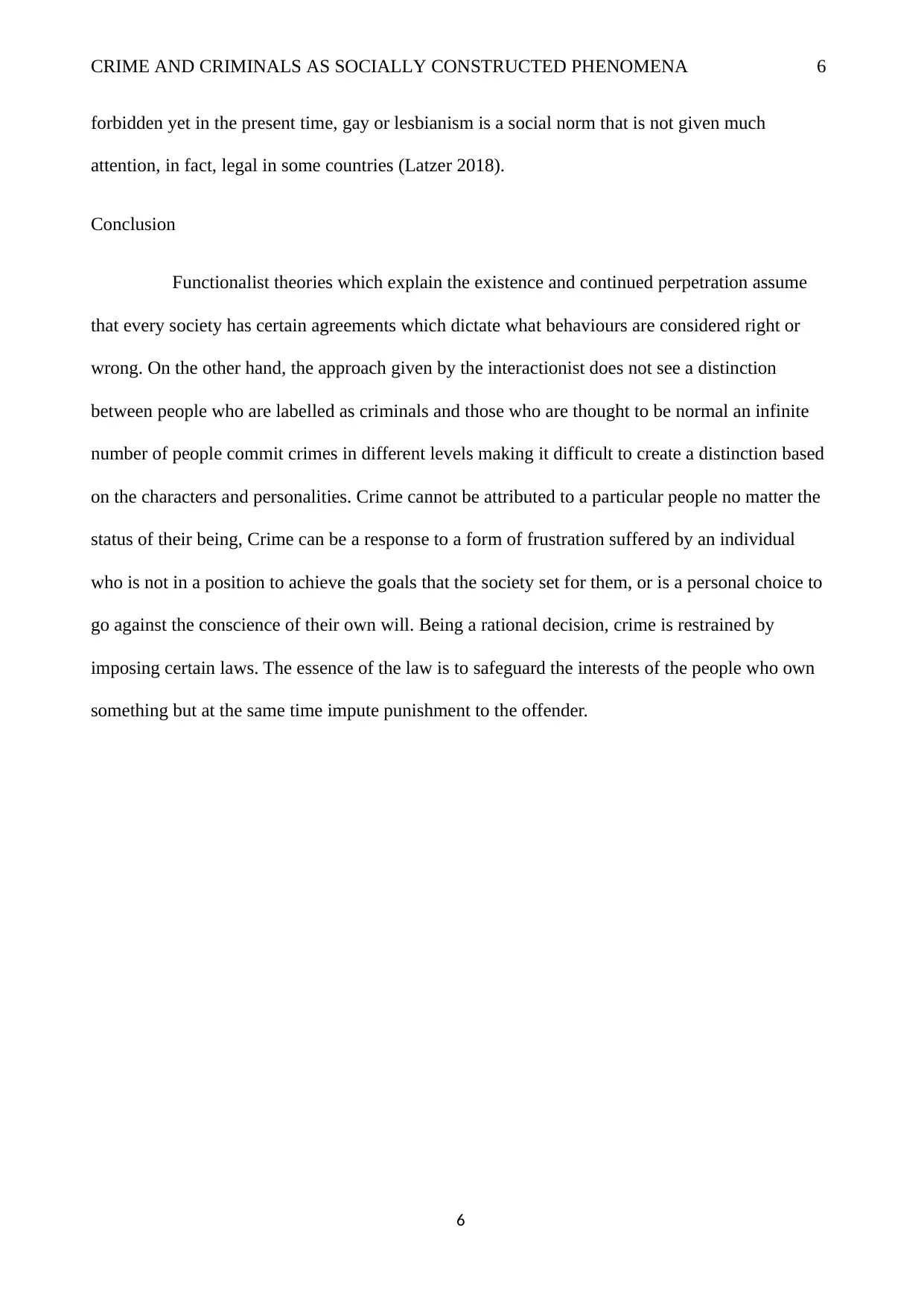
CRIME AND CRIMINALS AS SOCIALLY CONSTRUCTED PHENOMENA 6
forbidden yet in the present time, gay or lesbianism is a social norm that is not given much
attention, in fact, legal in some countries (Latzer 2018).
Conclusion
Functionalist theories which explain the existence and continued perpetration assume
that every society has certain agreements which dictate what behaviours are considered right or
wrong. On the other hand, the approach given by the interactionist does not see a distinction
between people who are labelled as criminals and those who are thought to be normal an infinite
number of people commit crimes in different levels making it difficult to create a distinction based
on the characters and personalities. Crime cannot be attributed to a particular people no matter the
status of their being, Crime can be a response to a form of frustration suffered by an individual
who is not in a position to achieve the goals that the society set for them, or is a personal choice to
go against the conscience of their own will. Being a rational decision, crime is restrained by
imposing certain laws. The essence of the law is to safeguard the interests of the people who own
something but at the same time impute punishment to the offender.
6
forbidden yet in the present time, gay or lesbianism is a social norm that is not given much
attention, in fact, legal in some countries (Latzer 2018).
Conclusion
Functionalist theories which explain the existence and continued perpetration assume
that every society has certain agreements which dictate what behaviours are considered right or
wrong. On the other hand, the approach given by the interactionist does not see a distinction
between people who are labelled as criminals and those who are thought to be normal an infinite
number of people commit crimes in different levels making it difficult to create a distinction based
on the characters and personalities. Crime cannot be attributed to a particular people no matter the
status of their being, Crime can be a response to a form of frustration suffered by an individual
who is not in a position to achieve the goals that the society set for them, or is a personal choice to
go against the conscience of their own will. Being a rational decision, crime is restrained by
imposing certain laws. The essence of the law is to safeguard the interests of the people who own
something but at the same time impute punishment to the offender.
6
⊘ This is a preview!⊘
Do you want full access?
Subscribe today to unlock all pages.

Trusted by 1+ million students worldwide
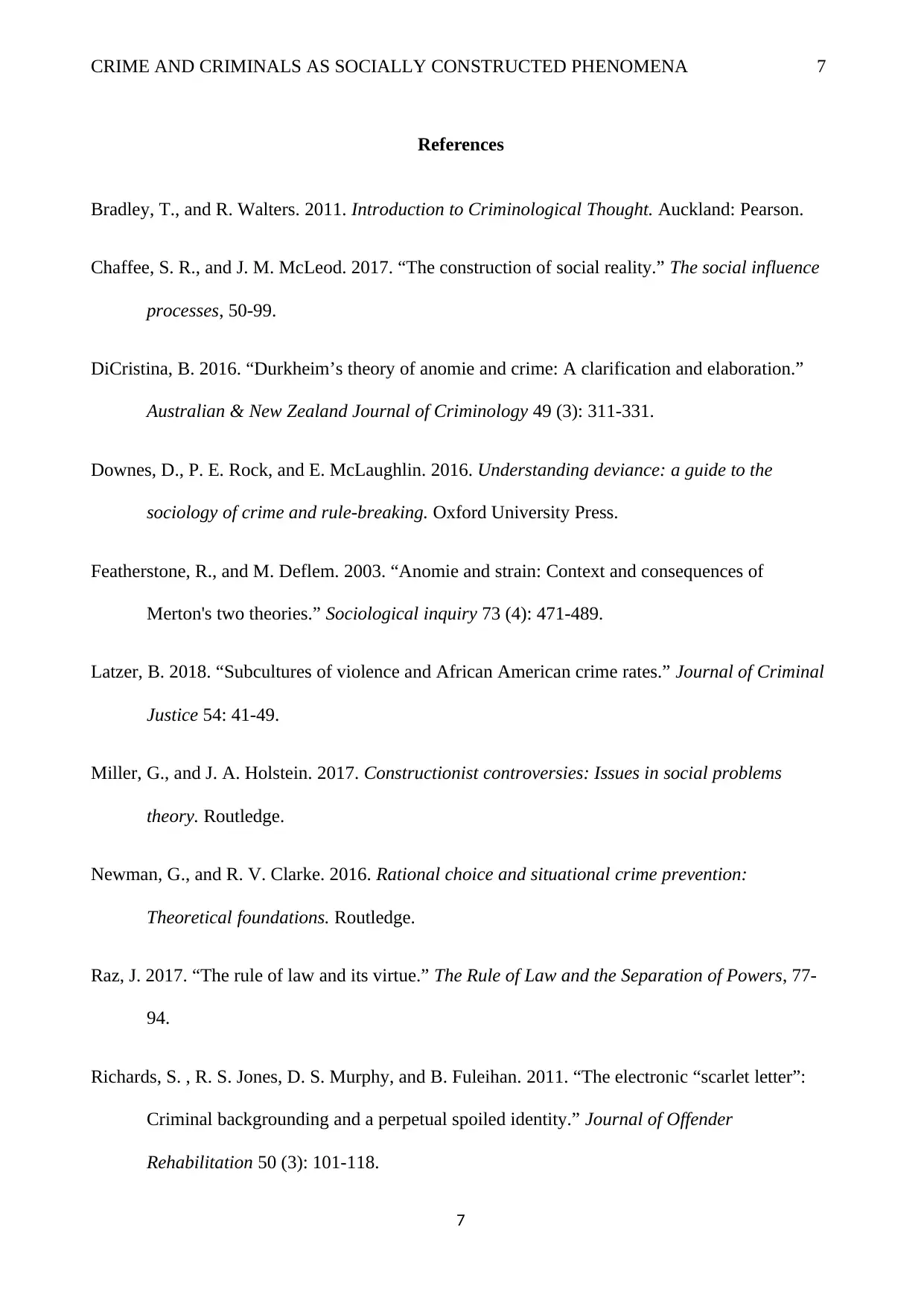
CRIME AND CRIMINALS AS SOCIALLY CONSTRUCTED PHENOMENA 7
References
Bradley, T., and R. Walters. 2011. Introduction to Criminological Thought. Auckland: Pearson.
Chaffee, S. R., and J. M. McLeod. 2017. “The construction of social reality.” The social influence
processes, 50-99.
DiCristina, B. 2016. “Durkheim’s theory of anomie and crime: A clarification and elaboration.”
Australian & New Zealand Journal of Criminology 49 (3): 311-331.
Downes, D., P. E. Rock, and E. McLaughlin. 2016. Understanding deviance: a guide to the
sociology of crime and rule-breaking. Oxford University Press.
Featherstone, R., and M. Deflem. 2003. “Anomie and strain: Context and consequences of
Merton's two theories.” Sociological inquiry 73 (4): 471-489.
Latzer, B. 2018. “Subcultures of violence and African American crime rates.” Journal of Criminal
Justice 54: 41-49.
Miller, G., and J. A. Holstein. 2017. Constructionist controversies: Issues in social problems
theory. Routledge.
Newman, G., and R. V. Clarke. 2016. Rational choice and situational crime prevention:
Theoretical foundations. Routledge.
Raz, J. 2017. “The rule of law and its virtue.” The Rule of Law and the Separation of Powers, 77-
94.
Richards, S. , R. S. Jones, D. S. Murphy, and B. Fuleihan. 2011. “The electronic “scarlet letter”:
Criminal backgrounding and a perpetual spoiled identity.” Journal of Offender
Rehabilitation 50 (3): 101-118.
7
References
Bradley, T., and R. Walters. 2011. Introduction to Criminological Thought. Auckland: Pearson.
Chaffee, S. R., and J. M. McLeod. 2017. “The construction of social reality.” The social influence
processes, 50-99.
DiCristina, B. 2016. “Durkheim’s theory of anomie and crime: A clarification and elaboration.”
Australian & New Zealand Journal of Criminology 49 (3): 311-331.
Downes, D., P. E. Rock, and E. McLaughlin. 2016. Understanding deviance: a guide to the
sociology of crime and rule-breaking. Oxford University Press.
Featherstone, R., and M. Deflem. 2003. “Anomie and strain: Context and consequences of
Merton's two theories.” Sociological inquiry 73 (4): 471-489.
Latzer, B. 2018. “Subcultures of violence and African American crime rates.” Journal of Criminal
Justice 54: 41-49.
Miller, G., and J. A. Holstein. 2017. Constructionist controversies: Issues in social problems
theory. Routledge.
Newman, G., and R. V. Clarke. 2016. Rational choice and situational crime prevention:
Theoretical foundations. Routledge.
Raz, J. 2017. “The rule of law and its virtue.” The Rule of Law and the Separation of Powers, 77-
94.
Richards, S. , R. S. Jones, D. S. Murphy, and B. Fuleihan. 2011. “The electronic “scarlet letter”:
Criminal backgrounding and a perpetual spoiled identity.” Journal of Offender
Rehabilitation 50 (3): 101-118.
7
Paraphrase This Document
Need a fresh take? Get an instant paraphrase of this document with our AI Paraphraser
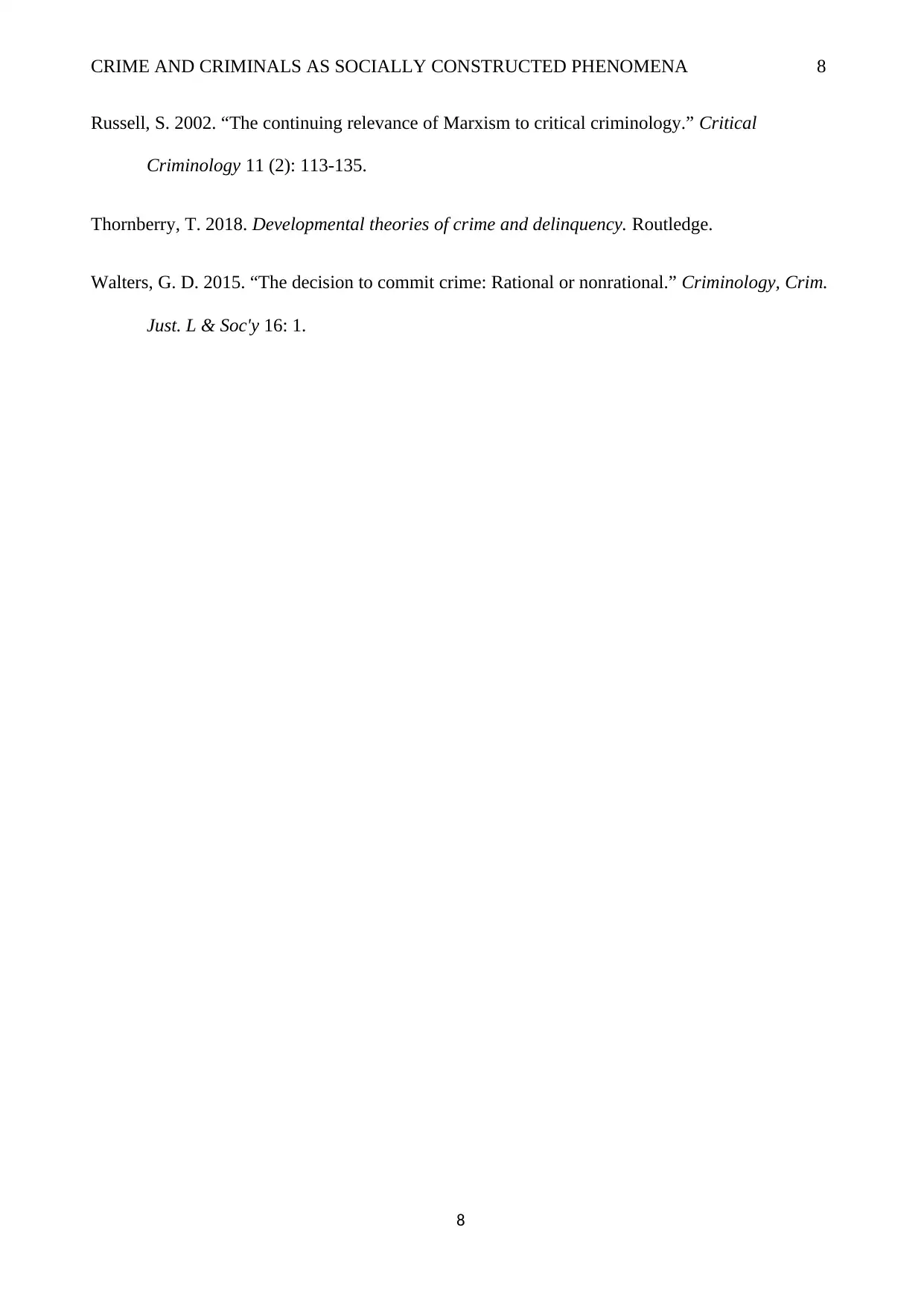
CRIME AND CRIMINALS AS SOCIALLY CONSTRUCTED PHENOMENA 8
Russell, S. 2002. “The continuing relevance of Marxism to critical criminology.” Critical
Criminology 11 (2): 113-135.
Thornberry, T. 2018. Developmental theories of crime and delinquency. Routledge.
Walters, G. D. 2015. “The decision to commit crime: Rational or nonrational.” Criminology, Crim.
Just. L & Soc'y 16: 1.
8
Russell, S. 2002. “The continuing relevance of Marxism to critical criminology.” Critical
Criminology 11 (2): 113-135.
Thornberry, T. 2018. Developmental theories of crime and delinquency. Routledge.
Walters, G. D. 2015. “The decision to commit crime: Rational or nonrational.” Criminology, Crim.
Just. L & Soc'y 16: 1.
8
1 out of 8
Related Documents
Your All-in-One AI-Powered Toolkit for Academic Success.
+13062052269
info@desklib.com
Available 24*7 on WhatsApp / Email
![[object Object]](/_next/static/media/star-bottom.7253800d.svg)
Unlock your academic potential
Copyright © 2020–2025 A2Z Services. All Rights Reserved. Developed and managed by ZUCOL.





